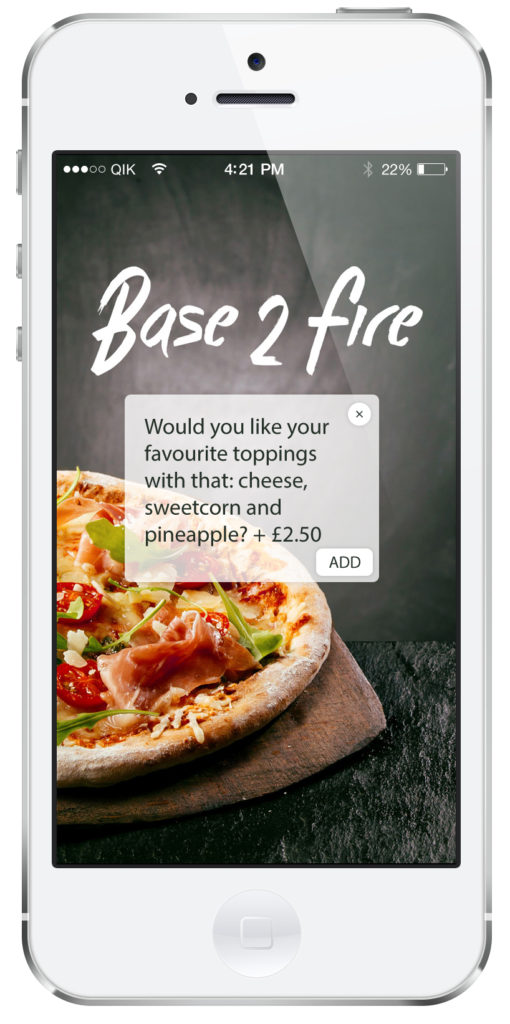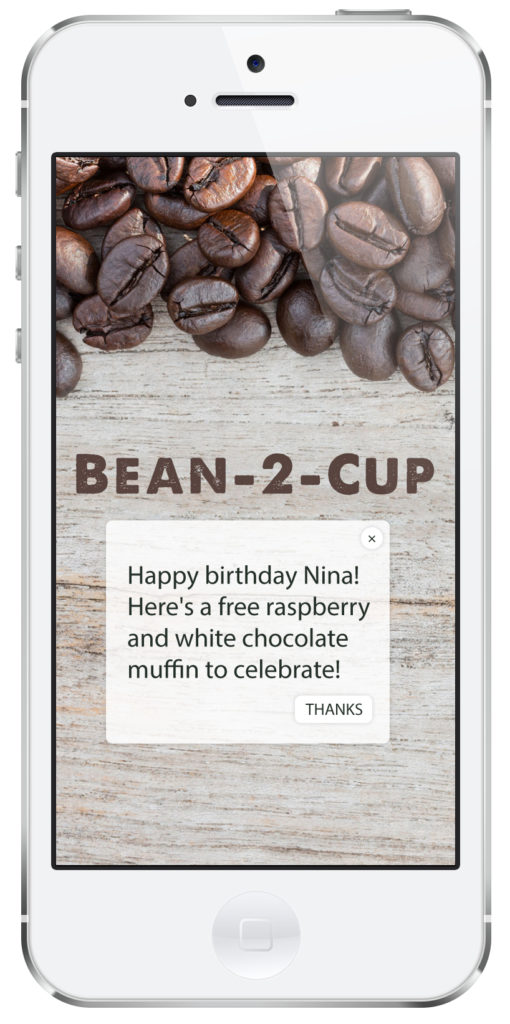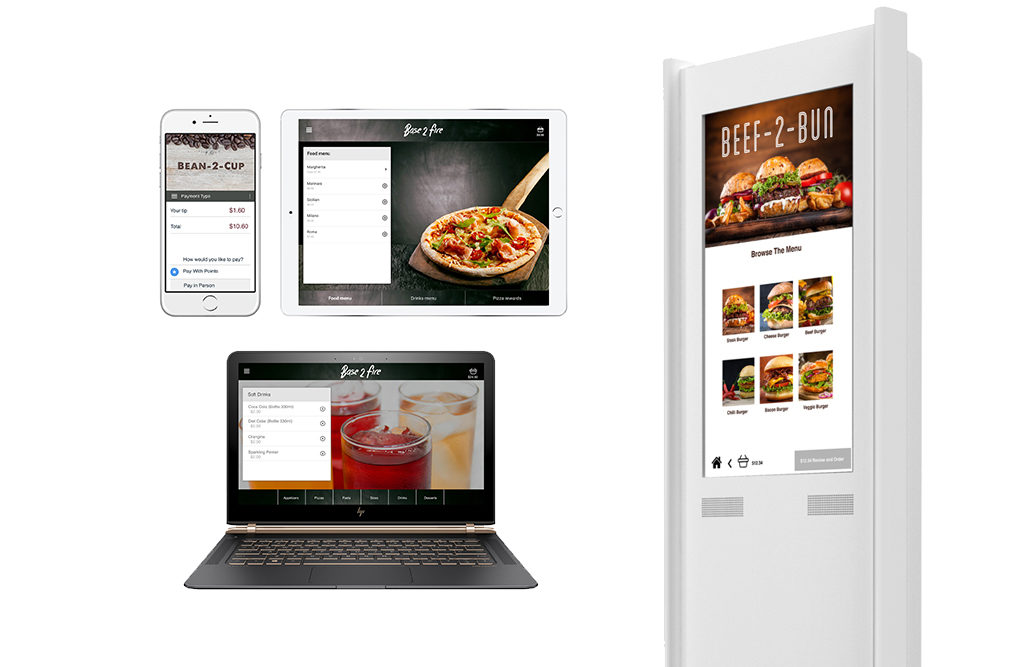We’ve all heard about the cost-savings moving to automation promises you but what about the direct ways customer-facing self-service solutions such as mobile, tablet and kiosk can actively drive revenues for you? Here are our top 5 ways automation in your quick service restaurants can play a direct role in bolstering your bottom line:
 1. Up-sell and cross-sell: A recent menu trends report has found operators are holding down the cost of main courses on their menus but boosting customer spend by focusing more on side dishes, snacks and nibbles. Upselling ancillary menu items can dramatically increase revenues but what happens when staff are unwilling or unable to do this effectively? This is where self-service steps in.
1. Up-sell and cross-sell: A recent menu trends report has found operators are holding down the cost of main courses on their menus but boosting customer spend by focusing more on side dishes, snacks and nibbles. Upselling ancillary menu items can dramatically increase revenues but what happens when staff are unwilling or unable to do this effectively? This is where self-service steps in.
Offering an upsell within your mobile, tablet or kiosk app when a guest is ordering a meal – at a relevant time and place – nudges them to think about other items they might like to order that best accompany their dish of choice and alleviates the pressure of staff standing over them while they make a decision.
When mobile apps capture customer data and can base future upsells and cross sells based on preferences and past behaviour, the uptake of these promotions become increasingly more successful. Not only that but there is an incremental improvement to the customer experience the more they use the app. The more the app is used, the better you get to know the customer and the more personalized, valuable and relevant you can make their experience.
2. Greater spend per order: Related to the above point about server-related pressure, research suggests that when customers are more relaxed and not under pressure to order with wait staff, they actually order more.
A study of 1,000s of transactions from QikServe clients showed an up-lift in spend per head of between 50% – 73% when they ordered through their mobile rather than wait staff. Pizza chains have also reported average pizza orders are 18% greater online and last year Starbucks attributed 5% of their 7% increase in sales to a 3 fold increase in average ticket size thanks to mobile ordering.
Although no formal studies have been conducted over the reasons why customers order more when they’re left to their own devices (literally), anecdotal evidence suggests without the pressure of staff standing over them expectantly waiting for an order, poised with pen and pad in hand, customers feel they have more time to browse the menu and order exactly what they want and include all the extras, drinks and sides they desire. There’s also the social judgement element of ordering via staff vs. device. A smartphone, tablet or kiosk will never judge you if you decide to order an extra large cheese burger with extra cheese, extra bacon and extra large soda. The more self-conscious section of your demographic might feel they can order away to their hearts content if given the choice to do it through your self-service channels.
3. Drive loyalty with a multi-channel approach to your customer needs. Customers are not only growing accustomed to self-service. They expect it. Whether it’s banking through a kiosk, shopping on a tablet or ordering through mobile – brands are becoming wise to the value customers place on the convenience of any where, any time self-service through any channel.
Quick service brands can actively increase the value of their customers by encouraging repeat visits and letting them take control of the way they interact and transact with you. By letting customers tailor their experience in the exact way that suits them, you set yourself apart from your competitors encouraging guests to return to you and enjoy the convenience and ease your brand has to offer.
In fact, a recent study by Deloitte found 40% of frequent restaurant visitors prefer to order online spending 26% more per order at QSRs. Even more telling, if QSR’s allow guests to use technology, they’ll come back 6% more often and spend 20% more each time. But what technology does this refer to? 31% of dine-in guests want to be able to pay by phone and of those, 50% would prefer to use the restaurant’s app.
 4. Increase customer lifetime value through personalization. Encourage repeat visits and greater spend through personalised marketing campaigns. The study by Deloitte mentioned above also found 70% of guests look for apps that deliver personalized offers. And when it comes to Millennials, personalization seems to be the key to their loyalty. Aimia found 51% of Millennials would share personal information so companies could send them relevant offers and discounts, 18% of Millennials stopped participating in a loyalty program because it lacked a smartphone app according to Colloquy and Forrester found 57% of mobile users admitted that loyalty programs and points are the top feature in a mobile wallet with 56% giving that title to discounts and deals.
4. Increase customer lifetime value through personalization. Encourage repeat visits and greater spend through personalised marketing campaigns. The study by Deloitte mentioned above also found 70% of guests look for apps that deliver personalized offers. And when it comes to Millennials, personalization seems to be the key to their loyalty. Aimia found 51% of Millennials would share personal information so companies could send them relevant offers and discounts, 18% of Millennials stopped participating in a loyalty program because it lacked a smartphone app according to Colloquy and Forrester found 57% of mobile users admitted that loyalty programs and points are the top feature in a mobile wallet with 56% giving that title to discounts and deals.
The beauty of a mobile order and payment app means you can automatically gather detailed information about your customers. Everything from which of your stores they eat at most frequently, whether they eat in groups, alone or as a family, what they like eating, how they like it cooked and what times they tend to come in. You can even record their payment preferences and card information to make it even easier for them to transact with you. All of this valuable data can be used to make your guests’ experience highly personalized and valuable encouraging them to choose you over and above that of any competition visit after visit.
 5. Drive greater footfall to restaurant with location-based marketing. A study by Microsoft found that 60% of consumers prefer offers targeted to where they are. Which makes sense. If you’re being offered your favourite meal of money off a coffee, ideally you’d want to be close to a store where you can redeem that offer. The longer you leave it, the more likely you are to forget about the offer and never redeem.
5. Drive greater footfall to restaurant with location-based marketing. A study by Microsoft found that 60% of consumers prefer offers targeted to where they are. Which makes sense. If you’re being offered your favourite meal of money off a coffee, ideally you’d want to be close to a store where you can redeem that offer. The longer you leave it, the more likely you are to forget about the offer and never redeem.
A mobile app is the perfect channel to execute effective location-based marketing. For example, in a sprawling airport, resort or shopping mall, you can attend to customers who linger in specific areas or locate guests to encourage them to visit your stores by sending offers made tantalizingly more tempting because of their close proximity.
The Golden State Warriors basketball team use location marketing to great effect sending welcome messages, promotions, upgrades and offers for better seats and special concession deals for the team store based on the fan’s location around the Oracle Arena.
There you have it. 5 ways automation can directly affect your revenues for the better. And we’ve not even touched on the other cost savings and operational efficiencies mobile, tablet, web and kiosk ordering can offer. From labor savings and queue busting to a reduction in erroneous order taking and drawing in crowds with eye catching, high res kiosk screens – multi-channel self-service delivers a wide range of benefits and for the savvy restauranteur eager to maximise their takings, it offers too many great opportunities to be ignored!.





